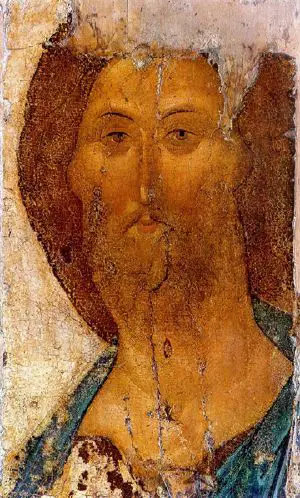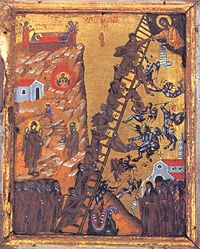Jesus Prayer
The Jesus Prayer (also called the Prayer of the Heart), is a short but widely used prayer in the Eastern Orthodox Church, which forms an integral part of Hesychasm. The most common form of the prayer involves repetition of the phrase, "Lord Jesus Christ, Son of God, have mercy on me, a sinner." The Jesus Prayer is found in the Philokalia, a collection of religious texts compiled by St. Nicodemus the Hagiorite and St. Makarios of Corinth.
Although Eastern Catholics use the Jesus Prayer, its practice has never achieved the same popularity in the Western Church as in the Eastern Orthodox Church. Moreover, the Eastern Orthodox theology of the Jesus Prayer enunciated in the fourteenth century by St. Gregory Palamas has never been fully accepted by the Roman Catholic Church.[1]
Today, the Jesus Prayer remains a popular part of devotional practice in Eastern Orthodox Christianity. It is especially popular among the monks of Mount Athos in Greece.
Origins
The prayer's origin most likely derives from the early Christian monks of the Egyptian desert, which was settled by the monastic Desert Fathers in the fifth century.[2]
The earliest known mention is in On Spiritual Knowledge and Discrimination of St. Diadochos of Photiki (400-ca. 486), a work found in the first volume of the Philokalia. The Jesus Prayer is described in Diadochos's work in terms very similar to Saint John Cassian's (ca. 360-435) description in the Conferences 9 and 10 of the repetitive use of a passage of the Psalms. St. Diadochos ties the practice of the Jesus Prayer to the purification of the soul and teaches that repetition of the prayer produces inner peace.
The practice of repeating the prayer continually dates back to at least the fifth century. The use of the Jesus Prayer is recommended in the Ladder of Divine Ascent of St. John Climacus (ca. 523â606) and in the work of St. Hesychios the Priest (ca. eigth century), Pros Theodoulon, found in the first volume of the Philokalia.
Theology
The Jesus Prayer is composed of two statements. The first one is a statement of faith, acknowledging the divine nature of Christ. The second one is the acknowledgment of ones own sinfulness. Out of them the petition itself emerges: "have mercy." For the Eastern Orthodox the power of the Jesus Prayer comes not from its content, but from the very invocation of the Jesus' name.
Theologically, the Jesus Prayer is considered to be the response of the Holy Tradition to the lesson taught by the parable of the Publican and the Pharisee, in which the Pharisee demonstrates the improper way to pray by exclaiming: "Thank you Lord that I am not like the Publican," whereas the Publican prays correctly in humility, saying "Lord have mercy on me, the sinner" (Luke 18:10-14).[3]

The Eastern Orthodox Church holds a non-juridical view of sin, by contrast to the satisfaction view of atonement for sin as articulated in the West, firstly by Anselm of Canterbury (as debt of honor) and Thomas Aquinas (as a moral debt). The terms used in the East are less legalistic (grace, punishment), and more medical (sickness, healing) with less exacting precision. Sin, therefore, does not carry with it the guilt for breaking a rule, but rather the impetus to become something more than what men usually are. One repents not because one is or is not virtuous, but because human nature can change. Repentance (metanoia, "changing one's mind") is not remorse, justification, or punishment, but a continual enactment of one's freedom, deriving from renewed choice and leading to restoration (the return to man's original state).[4]
As stated at the local Council of Constantinople in 1157, Christ brought his redemptive sacrifice not to the Father alone, but to the Trinity as a whole. In the Eastern Orthodox theology redemption is not seen as ransom. It is the reconciliation of God with man, the manifestation of Godâs love for humanity. Thus, it is not the anger of God the Father but His love that lies behind the sacrificial death of his son on the cross.
The redemption of man is not considered to have taken place only in the past, but continues to this day through theosis. The iniÂtiative belongs to God, but presupposes man's active accepÂtance (not an action only, but an attitude), which is a way of perpetually receiving God.[4]
Although some aspects of the Jesus Prayer may resemble some aspects of other traditions, its Christian character is central rather than mere "local color." The aim of the Christian practicing it is not humility, love, or purification of sinful thoughts, but becoming holy and seeking union with God (theosis), which subsumes them. Thus, for the Eastern Orthodox:
- The Jesus Prayer is, first of all, a prayer addressed to God. It is not a means of self-deifying or self-deliverance, but a counterexample to Adam's pride, repairing the breach it produced between man and God.
- The aim is not to be dissolved or absorbed into nothingness or into God, or reach another state of mind, but to (re)unite[5] with God (which by itself is a process) while remaining a distinct person.
- It is an invocation of Jesus' name, because Christian anthropology and soteriology are strongly linked to Christology in Orthodox monasticism.
- In a modern context the continuing repetition is regarded by some as a form of meditation, the prayer functioning as a kind of mantra. However, Orthodox users of the Jesus Prayer emphasize the invocation of the name of Jesus Christ that St. Hesychios describes in Pros Theodoulon which would be contemplation on the Triune God rather than simply emptying the mind.
- Acknowledging "a sinner" is to lead firstly to a state of humbleness and repentance, recognizing one's own sinfulness.
- Practicing the Jesus Prayer is strongly linked to mastering passions of both soul and body, e.g. by fasting. For the Eastern Orthodox not the body is wicked, but "the bodily way of thinking" is; therefore salvation also regards the body.
- Unlike mantras, the Jesus Prayer may be translated into whatever language the pray-er customarily uses. The emphasis is on the meaning not on the mere utterance of certain sounds.
- There is no emphasis on the psychosomatic techniques, which are merely seen as helpers for uniting the mind with the heart, not as prerequisites.
A magistral way of meeting God for the Eastern Orthodox, the Jesus Prayer does not harbor any secrets in itself, nor does its practice reveal any esoteric truths. Instead, as a hesychastic practice, it demands setting the mind apart from rational activities and ignoring the physical senses for the experiential knowledge of God. It stands along with the regular expected actions of the believer (prayer, almsgiving, repentance, fasting etc.) as the response of the Orthodox Tradition to Saint Paul's challenge to "pray without ceasing" (1 Thess 5:17).[3]
Practice
The practice of the Jesus Prayer is integrated into the mental ascesis undertaken by the Orthodox monastic in the practice of hesychasm. In the Eastern tradition the prayer is said or prayed repeatedly, often with the aid of a prayer rope (Russian: chotki; Greek: komvoskini), which is a cord, usually woolen, tied with many knots. The person saying the prayer says one repetition for each knot. It may be accompanied by prostrations and the sign of the cross, signaled by beads strung along the prayer rope at intervals. People who say the prayer as part of meditation often synchronize it with their breathing; breathing in while calling out to God and breathing out while praying for mercy.
Monks often pray this prayer many hundreds of times each night as part of their private cell vigil ("cell rule"). Under the guidance of an Elder (Russian Starets; Greek Gerondas), the monk aims to internalize the prayer, so that he is praying unceasingly. St. Diadochos of Photiki refers in On Spiritual Knowledge and Discrimination to the automatic repetition of the Jesus Prayer, under the influence of the Holy Spirit, even in sleep. This state is regarded as the accomplishment of Saint Paul's exhortation to the Thessalonians to "pray without ceasing" (1 Thessalonians 5:17).
Levels of the prayer

The early Church fathers condemned elaborate phraseologies of prayer for one word was enough for the publican, and one word saved the thief on the cross. They only uttered Jesus' name by which they were contemplating God. As general guidelines for the practitioner, different number of levels (three, seven, or nine) in the practice of the prayer are distinguished by Orthodox fathers. They are to be seen as being purely informative, because the practice of the Prayer of the Heart is learned under personal spiritual guidance in Eastern Orthodoxy which emphasizes the perils of temptations when it's done by one's own. Thus, Theophan the Recluse, a nineteenth century Russian spiritual writer, talks about three stages:[3]
- The oral prayer (the prayer of the lips) is a simple recitation, still external to the practitioner.
- The focused prayer, when "the mind is focused upon the words" of the prayer, "speaking them as if they were our own."
- The prayer of the heart itself, when the prayer is no longer something we do but who we are.
Others, like Father Archimandrite Ilie Cleopa, one of the most representative spiritual fathers of contemporary Romanian Orthodox monastic spirituality, talk about nine levels. They are the same path to theosis, more slenderly differentiated:
- The prayer of the lips.
- The prayer of the mouth.
- The prayer of the tongue.
- The prayer of the voice.
- The prayer of the mind.
- The prayer of the heart.
- The active prayer.
- The all-seeing prayer.
- The contemplative prayer.
In its more advanced use, the monk aims to attain to a sober practice of the Jesus Prayer in the heart free of images. It is from this condition, called by Saints John Climacus and Hesychios the "guard of the mind," that the monk is said to be raised by the Divine grace to contemplation.
Due to the flexibility of the practice of the Jesus Prayer, there is no imposed standardization of its form. The prayer can be from as short as "Have mercy on me" ("Have mercy on us"), or even "Jesus," to its longer most common form. It can also contain a call to the Theotokos (Virgin Mary), or to the saints. The single essential and invariable element is Jesus' name. Some of the variants of the prayer include:
- "Lord Jesus Christ, Son of God, have mercy on me, a sinner."
- "Lord Jesus Christ, have mercy on me."
- "Lord have mercy."
- "Jesus have mercy."
- "Christ have mercy."
Notes
- â Pope John Paul II's Angelus Message Retrieved July 14, 2008.
- â Antoine Guillaumont reports the finding of an inscription containing the Jesus Prayer in the ruins of a cell in the Egyptian desert dated roughly to the period being discussed. Antoine Guillaumont, Une inscription copte sur la priĂšre de Jesus in Aux origines du monachisme chrĂ©tien, Pour une phĂ©nomĂ©nologie du monachisme, pp. 168â83. In SpiritualitĂ© orientale et vie monastique, No 30. BĂ©grolles en Mauges (Maine & Loire), France: Abbaye de Bellefontaine.
- â 3.0 3.1 3.2 Fr. Steven Peter Tsichlis, The Jesus Prayer, Greek Orthodox Archdiocese of America. Retrieved July 14, 2008.
- â 4.0 4.1 John Chryssavgis, Repentance and Confession - Introduction, Greek Orthodox Archdiocese of America. Retrieved July 15, 2008.
- â Unite if referring to one person; reunite if talking at an anthropological level.
ReferencesISBN links support NWE through referral fees
- Henry, Gary, and Jonathan Montaldo. Merton and Hesychasm: The Prayer of the Heart & the Eastern Church (The Fons Vitae Thomas Merton series). Vitae, 2003. ISBN 9781887752459
- LaBauve, Maurice. Hesychasm, word-weaving, and Slavic hagiography: The literary school of Patriarch Euthymius. HĂ©bert Sagner, 1992. ISBN 9783876905303
- Leloup, Jean-Yves. Being Still: Reflections on an Ancient Mystical Tradition. Paulist Press, 2003. ISBN 9780809141777
- Markides, Kyriacos C. The Mountain of Silence: A Search for Orthodox Spirituality. Image, 2002. ISBN 9780385500920
- Meyendorff, John. Gregory Palamas: The Triads (Classics of Western Spirituality). Paulist Press; New Ed edition, 1982. ISBN 9780809124473
Credits
New World Encyclopedia writers and editors rewrote and completed the Wikipedia article in accordance with New World Encyclopedia standards. This article abides by terms of the Creative Commons CC-by-sa 3.0 License (CC-by-sa), which may be used and disseminated with proper attribution. Credit is due under the terms of this license that can reference both the New World Encyclopedia contributors and the selfless volunteer contributors of the Wikimedia Foundation. To cite this article click here for a list of acceptable citing formats.The history of earlier contributions by wikipedians is accessible to researchers here:
The history of this article since it was imported to New World Encyclopedia:
Note: Some restrictions may apply to use of individual images which are separately licensed.
